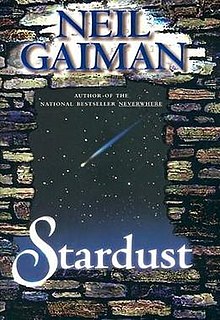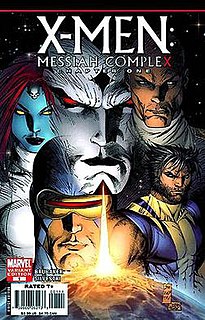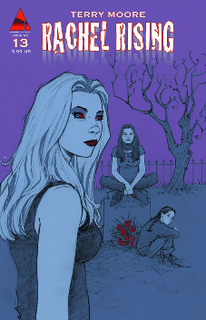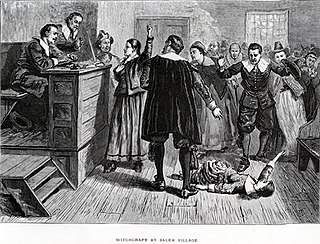
Stardust is a 1997 fantasy novel by British writer Neil Gaiman, usually published with illustrations by Charles Vess. Stardust has a different tone and style from most of Gaiman's prose fiction, being consciously written in the tradition of pre-Tolkien English fantasy, following in the footsteps of authors such as Lord Dunsany and Hope Mirrlees. It is concerned with the adventures of a young man from the village of Wall, which borders the magical land of Faerie.

The Crucible is a 1953 play by American playwright Arthur Miller. It is a dramatized and partially fictionalized story of the Salem witch trials that took place in the Massachusetts Bay Colony during 1692–93. Miller wrote the play as an allegory for McCarthyism, when the United States government persecuted people accused of being communists. Miller was questioned by the House of Representatives' Committee on Un-American Activities in 1956 and convicted of contempt of Congress for refusing to identify others present at meetings he had attended.

The Salem witch trials were a series of hearings and prosecutions of people accused of witchcraft in colonial Massachusetts between February 1692 and May 1693. More than two hundred people were accused. Thirty were found guilty, nineteen of whom were executed by hanging. One other man, Giles Corey, was pressed to death for refusing to plead, and at least five people died in jail.
John Proctor was a landowner in the Massachusetts Bay Colony. He was the son of John Proctor, Sr. (1594–1672) and Martha Harper (1607–1667). He was hanged on August 19, 1692 in Salem Village, Massachusetts Bay Colony during the Salem Witch Trials after being falsely accused and convicted for witchcraft.

Sabrina the Teenage Witch is a comic book series published by Archie Comics about the adventures of a fictional American teenager named Sabrina Spellman. Sabrina was created by writer George Gladir and artist Dan DeCarlo, and first appeared in Archie's Madhouse #22. Storylines of the character at elementary-school-age also appear under the title "Sabrina -- That Cute Little Witch" in almost all of the Little Archie comics.

Tituba was the first woman to be accused of practicing witchcraft during the 1692 Salem witch trials. She was enslaved and owned by Samuel Parris of Danvers, Massachusetts. Although her origins are debated, research has suggested that she was a South American native and sailed from Barbados to New England with Samuel Parris. Little is known regarding Tituba's life prior to her enslavement. She became a pivotal figure in the witch trials when she confessed to witchcraft while also making claims that both Sarah Good and Sarah Osborne participated in said witchcraft. She was imprisoned and later released by Samuel Conklin, but little to nothing is known about Tituba's life following her subsequent release.

Spellbinders is a comic book published by Marvel Comics, as part of that company's Marvel Next imprint. It was a six-issue limited series written by Mike Carey with art by Mike Perkins. It is part of the Marvel Universe, but the story takes no advantage of the fact.

The Haunt of Fear was an American bi-monthly horror comic anthology series published by EC Comics, starting in 1950. Along with Tales from the Crypt and The Vault of Horror, it formed a trifecta of popular EC horror anthologies. The Haunt of Fear was sold at newsstands beginning with its May/June 1950 issue. It ceased publication with its November/December 1954 issue, compiling a total of 28 issues.

Sarah Good was one of the first three women to be accused of witchcraft in the Salem witch trials, which occurred in 1692 in colonial Massachusetts.
Ann Foster was an Andover widow accused of witchcraft during the Salem witch trials.

Mercy Lewis was an accuser during the Salem Witch Trials. She was born in Falmouth, Maine. Mercy Lewis, formally known as Mercy Allen, was the child of Philip Lewis and Mary (Cass) Lewis.

"X-Men: Messiah Complex" is an American comic book crossover storyline published by Marvel Comics from October 2007 to January 2008, which ran through the various X-Men books.

Cultural depictions of the Salem witch trials abound in art, literature and popular media in the United States, from the early 19th century to the present day. The literary and dramatic depictions are discussed in Marion Gibson's Witchcraft Myths in American Culture and see also Bernard Rosenthal's Salem Story: Reading the Witch Trials of 1692
This timeline of the Salem witch trials is a quick overview of the events.
Deodat Lawson was a minister in Salem Village from 1684 to 1688 and is famous for a 10-page pamphlet describing the witchcraft accusations in the early spring of 1692. The pamphlet was billed as "collected by Deodat Lawson" and printed within the year in Boston, Massachusetts.
Elizabeth Howe was one of the accused in the Salem witch trials. She was found guilty and executed on July 19, 1692.

Chilling Adventures of Sabrina is an American comic book series published by Archie Horror, an imprint of Archie Comics, beginning in 2014. The series is a darker take on the characters and setting of Sabrina the Teenage Witch. It is written by Roberto Aguirre-Sacasa, with art by Robert Hack, and is inspired by the appearances of Sabrina in Aguirre-Sacasa's other Archie series, Afterlife with Archie.

Rachel Rising is a 42-issue American comic book series created by Terry Moore and published through Abstract Studio. The first issue was released on August 3, 2011, to positive reviews. Reviewers sometimes criticized the pace later in the run, but the series won industry awards throughout its publication. Since its conclusion in 2016, members of the cast have reappeared in other works by Moore. Plans for a television adaptation were announced April 17, 2013, but was still in the scripting stage in 2015.

Martha Carrier was a Puritan accused and convicted of being a witch during the 1692 Salem witch trials.














